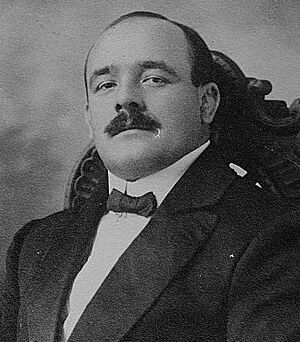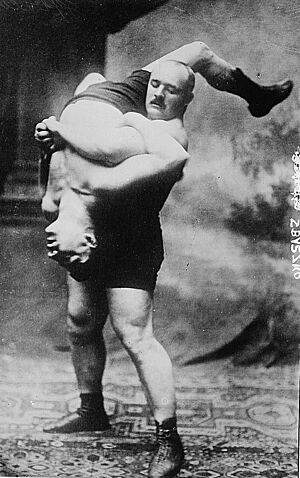Stanislaus Zbyszko facts for kids
Quick facts for kids Stanislaus Zbyszko |
|
|---|---|

Zbyszko circa 1919
|
|
| Birth name | Jan Stanisław Cyganiewicz |
| Born | April 1, 1879 Jodłowa, Austria-Hungary (now Poland) |
| Died | September 23, 1967 (aged 88) St. Joseph, Missouri, U.S. |
| Family | Wladek Zbyszko (brother) |
| Professional wrestling career | |
| Ring name(s) | Stanislaus Zbyszko |
| Billed height | 5 ft 8 in (1.73 m) |
| Billed weight | 230 lb (100 kg) |
| Billed from | Vienna, Austria |
| Trained by | Władysław Pytlasiński |
| Debut | 1901 |
| Retired | 1934 |
| Signature | |
 |
|
Jan Stanisław Cyganiewicz (born April 1, 1879 – died September 23, 1967) was a famous Polish strongman and professional wrestler. He was better known by his ring name, Stanislaus Zbyszko. People sometimes called him "Zbysco" in newspapers. During the 1920s, he was a three-time World Heavyweight Champion in the United States. The name Zbyszko was a nickname given to him by friends. It came from a brave knight in a Polish novel called The Knights of the Cross. Stanislaus Zbyszko also had a younger brother, Wladek Zbyszko, who was also a wrestler.
Contents
Early Life and Training
Stanislaus Cyganiewicz was born on April 1, 1879, in Jodłowa, a town near Kraków, Poland. He was a very smart person who studied music, philosophy, and law in Vienna, Austria, when he was young.
Stanislaus was a strong and well-built man. He stood about 5 feet 8 inches tall and weighed around 260 pounds. While in college, he joined the famous Vindobona Athletic Club. There, he worked hard to build his impressive body. He also trained with the Sokol ("Falcon") group. This was a Polish group that helped people improve their physical, mental, and cultural skills.
His journey into wrestling began when he beat an experienced wrestler at a circus in Poland. Soon after, a promoter invited him to Berlin. Stanislaus was inspired by another strongman, George Hackenschmidt, who was a top wrestler in Europe. Stanislaus decided to become a professional wrestler too. He was taught by a Polish grappler named Władysław Pytlasiński, who became his mentor.
Wrestling Career Highlights
Over the next few years, Stanislaus Zbyszko became one of Europe's best Greco-Roman wrestlers. He competed in many tournaments. By 1903, he was known as one of the continent's top heavyweights.
In 1906, he had a two-hour match against Russia's "Cossack" Ivan Poddubny that ended in a draw. After that, he won a big tournament in Paris, beating wrestlers like Georg Lurich. He then went to England, where he wrestled against Kara Suliman from Turkey. However, it was later found out that Suliman was actually Ivan Offtharoff, who worked for Zbyszko. This was one of the first times people realized that some wrestling matches were planned.
Switching Wrestling Styles
As Zbyszko wrestled more in England and the United States, he started to learn catch-as-catch-can freestyle wrestling. For several years, he switched between Greco-Roman and freestyle wrestling as he traveled.
In November 1909, he wrestled Frank Gotch in Buffalo, New York. The match lasted one hour and ended in a draw. This showed that Zbyszko was one of the world's best freestyle wrestlers. The next year, he beat Dr. Ben Roller and Youssuf Mahmout, proving his skill.
The Famous Rematch with Frank Gotch
On June 1, 1910, Zbyszko had a big rematch with Frank Gotch in Chicago. This match was for the World Heavyweight Championship. However, Gotch surprised Zbyszko at the start of the match. Zbyszko expected a handshake, which was common in Europe, but Gotch quickly pinned him in just 6.4 seconds. Zbyszko was very angry and protested, but the match continued. Gotch won the second fall in under 30 minutes. Many fans thought this match was planned because of how quickly it ended. Gotch never wrestled Zbyszko again after this.
Facing the Great Gama
Even with the controversial loss, Zbyszko was still seen as one of the best wrestlers. He then took on a huge challenge: India's undefeated champion, Great Gama. Gama had tried to get Gotch to wrestle him, but it didn't happen.
On September 10, 1910, Zbyszko faced the Great Gama in London for the John Bull World Championships. The winner would get £250 and the John Bull Belt. Zbyszko used a defensive strategy, staying on the mat to stop Gama's strengths. The match lasted almost three hours and ended in a draw. Many fans were not happy because Zbyszko didn't attack much. However, Zbyszko was one of the few wrestlers who didn't lose to the Great Gama.
They were supposed to have another match on September 17, 1910. But Zbyszko did not show up, so Gama was declared the winner by default. Gama received the prize and the John Bull Belt, which made him the World Champion. For the next ten years, Zbyszko wrestled in Europe. Meanwhile, his younger brother, Wladek Zbyszko, became a top wrestling star in the United States.
In 1927, it was announced that the Great Gama and Zbyszko would wrestle again. They met in 1928 in Patiala. This match also ended in a draw, with Gama throwing Zbyszko in only 42 seconds.
Life After Wrestling
In 1928, Zbyszko got a great offer to wrestle the Great Gama again. This was 18 years after their first match. Even though both wrestlers were older, about 60,000 fans came to watch. Great Gama defeated Zbyszko in just 40 seconds.
After this match, Zbyszko retired from wrestling. He started looking for new wrestling talent in South America. There, he discovered Antonino Rocca, who was a soccer player, rugby player, boxer, wrestler, and gymnast. Zbyszko helped Rocca become a huge star in wrestling.
From their farm in Missouri, the Zbyszko brothers also trained future wrestling legends like Johnny Valentine and Harley Race. Stanislaus also had a small role in the movie Night and the City (1949). The director, Jules Dassin, wanted a real wrestling legend for the role. He found Zbyszko, who was a chicken farmer in New Jersey. Dassin described Zbyszko as a "beautiful, cultured, multilingual man." Zbyszko often talked about how wrestling was changing into more of a show, which was something his character in the movie also complained about.
Stanislaus Zbyszko passed away on September 23, 1967, at the age of 88, due to a heart attack. Many people remember him as one of the best true wrestlers of all time. As a tribute, another wrestler, Larry Zbyszko, later adopted his last name.
In 1983, Stanislaus Zbyszko was honored by being inducted into the National Polish American Sports Hall of Fame.
Achievements and Awards
Stanislaus Zbyszko received many honors for his wrestling career:
- George Tragos/Lou Thesz Professional Wrestling Hall of Fame
- Inducted in 2010
- International Professional Wrestling Hall of Fame
- Inducted in 2021
- Professional Wrestling Hall of Fame
- Inducted in 2003 as a Pioneer Era wrestler (1898-1942)
- Wrestling Observer Newsletter
- Wrestling Observer Newsletter Hall of Fame (Class of 1996)
- Other Championships:
- World Heavyweight Championship (Catch as Catch Can version) (won 3 times)
- World Greco-Roman Heavyweight Championship
Film Appearances
Stanislaus Zbyszko appeared in a couple of movies:
| Year | Title | Role | Notes |
|---|---|---|---|
| 1932 | Madison Square Garden | Himself | |
| 1950 | Night and the City | Gregorius | This was his last movie role. |
Images for kids



